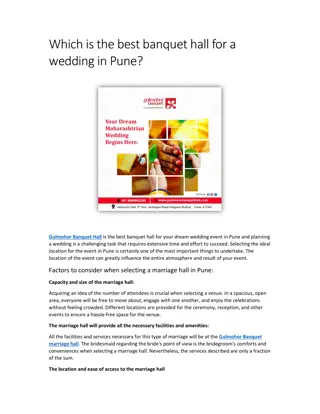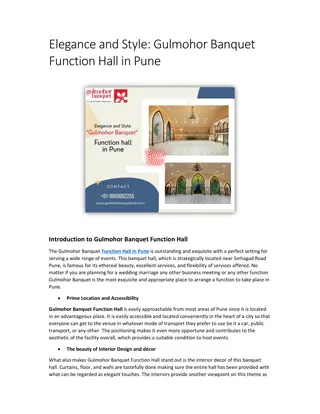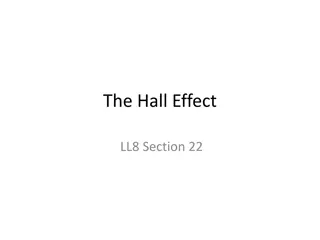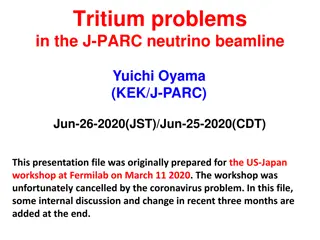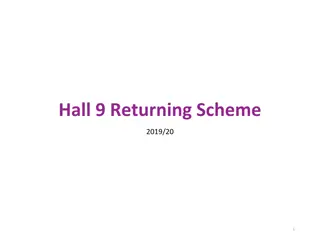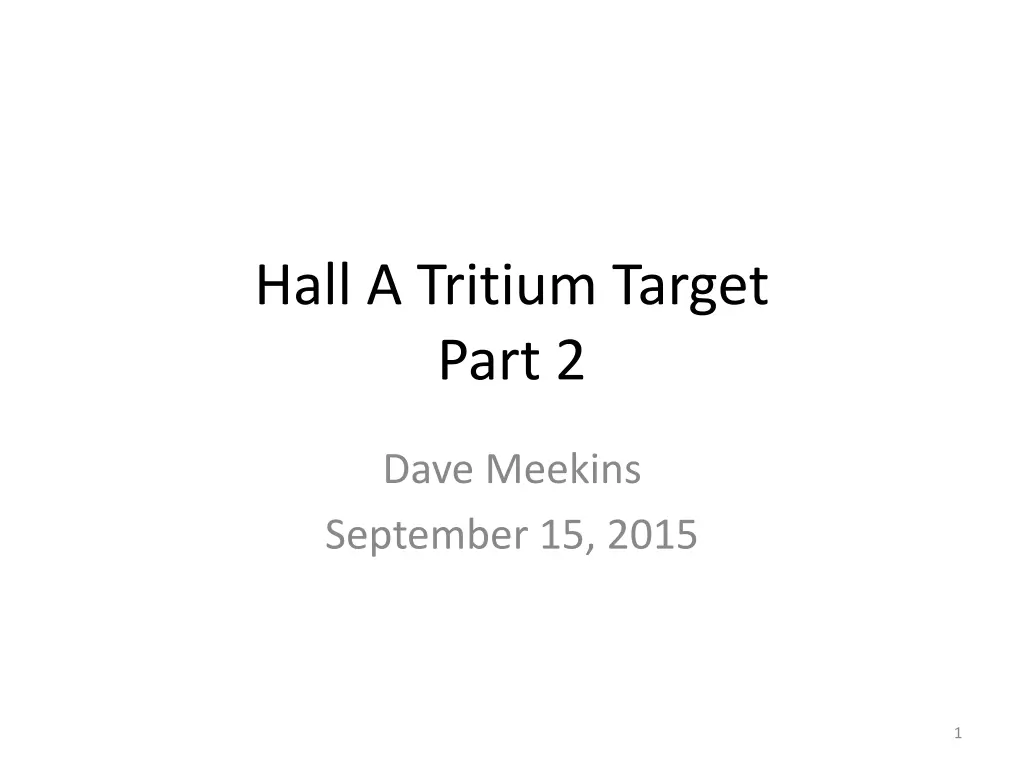
Tritium Target Assembly and Testing Procedures
Learn about the detailed assembly and testing procedures for tritium targets, including containment levels, filling and shipping processes, intermediate vessel specifications, and installation plans at JLAB. Follow step-by-step guidelines for pre-installation tasks, installation procedures, and controlling access in the Hall area. Ensure safety measures and compliance with regulations throughout the process.
Uploaded on | 2 Views
Download Presentation

Please find below an Image/Link to download the presentation.
The content on the website is provided AS IS for your information and personal use only. It may not be sold, licensed, or shared on other websites without obtaining consent from the author. If you encounter any issues during the download, it is possible that the publisher has removed the file from their server.
You are allowed to download the files provided on this website for personal or commercial use, subject to the condition that they are used lawfully. All files are the property of their respective owners.
The content on the website is provided AS IS for your information and personal use only. It may not be sold, licensed, or shared on other websites without obtaining consent from the author.
E N D
Presentation Transcript
Hall A Tritium Target Part 2 Dave Meekins September 15, 2015 1
Tritium Containment Three levels of containment for all conditions Shipping 1) Cell with covers installed 2) Intermediate vessel 3) Shipping container Installation/removal 1) Cell with covers 2) Transfer Hut 3) Hall A General Operations 1) Cell (no covers) 2) Scattering chamber 3) Hall A 2
Assembly and Testing at JLAB Each component shall be cleaned and inspected for defects and dimensional tolerance The cell shall be assembled (no covers) documented on assembly/test form Leak testing (per Code) at 550 psi He reverse mode. Close valve and check leak thru in reverse mode. Install covers and test to 1100 psi Meets Code requirements 110% design pressure Assemble with valve covers insert into intermediate vessel (IV) Load IV into shipping container 3
Filling/Shipping Filling to occur at SRTE in glove box with covers installed Decon and package per SRTE requirements Process can take 2-3 weeks. Ensure heat strapping in place Ship to JLAB 4
Shipping Container Alloy Product Corp. 55 Gal DOT/UN vessel 24 in ID Flanged top Can this be made a Type A container? Containment Level 3 6
Pre-Installation Plan Test/assemble per procedure Perform all examinations and tests required by B31.3 on cryosystem Install and test exhaust system (all speeds) Interlock testing not required until Aug 2016. Install backup power/test Install access platform Test install Hut (June 2016) Check flow train and remove hut Install target on pivot as usual and align Check/test T2 alarm system Check/test vacuum fault system Test all interlocks on exhaust system Check/test FSD system Install Hut and check flow (low speed) Install cell 7
Installation Procedure Outline All pre-installation tasks shall be performed including the placement of tools and materials in preparation for cell installation or removal. A special tritium target tool box shall be maintained for this specific purpose and no other, by the JLAB Target Group. The exhaust system shall be activated at low speed and flow shall be verified. The shipping container holding the cell shall be placed in the handling hut. The Hall shall be placed in controlled access. This includes a full sweep and key access. Entrance to the Hall shall only be allowed for personnel directly involved in the installation/removal process. These activities shall be 100% covered by RadCon operating under a specific RWP. Upon completion of the cell installation, the team closing the chamber may enter the hall to perform this specific task while being supported by RadCon and the Target Group. The JLAB DA shall be responsible for the cell installation removal. Once the chamber is sealed and vacuum is established the Hall may be returned to restricted access. 8
Controlled Access Procedure Outline Ensure Target is in Home Position Make entry as required with the additional training requirements for tritium. Ensure that ARM/RadCon has handheld TAM (tritium air monitor). The maintenance of these monitors is the purview of the RadCon group. All large truck ramp doors shall remain closed during this access Access is allowed to the Hall if an acceptable level of tritium is detected. Note that it is assumed that there will be some airborne tritium from normal beam operations present in the Hall. If unacceptable levels of tritium are found then exit immediately and inform RadCon. Activate the exhaust system and await further instructions. All personnel on the access team shall be enrolled in the bio-assay program. The following activities are not allowed during a controlled access for these accesses: Forklift operations Lift operations within 20 ft of the pivot Crane operations Heavy work (other than diagnostic and tuning) within 20 ft of the pivot. Should the TAM alarm at any point during the access, all personnel shall promptly leave the Hall and activate the exhaust system. Notify RadCon for further requirements. Should power fail, all personnel shall promptly leave the Hall. 9
Truck Ramp Protocols At the start of this procedure all ramp doors shall be closed. For loads entering the Hall: The top ramp door shall be opened by personnel located on the inside of the ramp. The vehicle carrying this load shall enter the truck ramp. The upper door shall be closed and the load carried to the bottom of the ramp. The lower door shall be opened. This activates the high speed exhaust system which should provide sufficient noise to ensure a strong desire to reclose the lower door. If the lower door can be closed (i.e. the truck is not stuck half way) then it shall. The load shall be brought into the Hall and unloaded promptly and safely. Once the load is removed the truck shall exit the Hall Promptly and the lower door closed. The truck may proceed to the top of the ramp where the upper door is opened temporarily to allow its passage. For loads leaving the Hall the truck shall enter as above. Upon reaching the interior of the Hall it shall be loaded promptly and exit the Hall forthwith using the same procedure as above. 10
Restricted Access Procedure Outline The access to the Hall shall be controlled through the CANS system. Truck ramp protocols as described above shall be followed. To change to or from controlled access the scattering chamber window covers shall be removed/installed. All work within 20 ft of the pivot shall be covered by a handheld TAM monitor. At least one TAM shall be available at the entrance of the Hall for access. When personnel are in Hall this TAM must remain located near the pivot. It shall be maintained by the RadCon group. Should power fail, all personnel shall promptly leave the Hall. Heavy work (crane operations, operations requiring hand tool work directly on the chamber, fork lift operations etc.) performed within 20 ft of the chamber shall be governed by an RWP. 11
Procedures to be Developed FSD checkout procedure Modified to include FSDs from tritium target which are additional to the standard cryogenic target FSDs. Hall checklist Hut installation and removal Tritium target installation and removal Tritium cell inspection and assembly procedure. Procedure is complete and shall be filed in Document Control Component cleaning procedure This procedure is complete and shall be filed in Document Control. T2 Exhaust testing procedure This procedure is required to ensure that the exhaust system is functioning correctly in all modes. It shall be filed in Document Control. Access to Hall A Restricted access to Hall A shall be limited to personnel with specific tritium training. Controlled access to Hall shall be similar to the current Controlled Access protocols. These procedures shall be filed as part of the Experimental Physics Documents (e.g. COO, ESAD, RSAD, etc.). Target operating procedures. T2 alarm checkout procedures 12
Tritium Release Models 3 scenarios have been developed 1) Cell/chamber failure with worker fully exposed in Hall (outside Hall A exposures in Case 2 and 3) 2) Cell failure with no containment and release to Hall A truck ramp 3) Contained release with Tritium stacked 4) Release while handling cell All scenarios consider 1090 Ci Immediate 10% conversion of T2 to HTO in atmosphere is assumed (Pan and Rigdon) Dose from HTO is 10000 times HT Immediate 5% conversion to HTO is assumed for in Hall release 13
Case 1: Maximum Expected Dose to Worker in Hall Primary (cell) and Secondary (chamber) containment breached 1100 Ci release to Hall Exhaust system does not function Tritium alarm/leak detected workers leave in ten minutes 5% conversion to HTO T2 is assumed to expand to chamber (1900 L) Worker exposed to this concentration for full 10 min. Calculation details given in TGT-CALC-103-004 Maximum expected dose to worker is 1.2 rem 14
Case 2: Uncontrolled Release Ground Level (Truck Ramp Exit) Assumes that the release is 1100 Ci of HT with 10% HTO Release is at ground level Modeled using HotSpot Stability Class F Wind directed at closest boundary 1 day exposure time Max expected dose at top of ramp 1.5 rem Max expected dose at 300m 4.8 mrem 15
Case 3: Controlled Through Stack Assumes that the release is 1100 Ci of HT with 10% HTO Can come from chamber or Hall but does go through the exhaust. Release is at 20m above grade at boundary Modeled using HotSpot Stability Class F Wind directed at closest boundary 1 day exposure time Max expected dose 1 mrem. 18
Case 4) Cell handling release Hut is installed on chamber adapter Exhaust is continuously on low for all handling operations 150 fpm across all openings prevents T2 loss T2 drawn from workers through chamber up stack Exposure less than Case 1 and Case 3 applies. 21
Tritium Release Summary Extensive measures have been taken to prevent releases. Case 3) Presents a controlled release Operational containment levels 2 and 3 only catch T2 for a controlled release. All cases lower than required limits. 5 rem to workers 10 mrem at 300m Case 2 release will not happen if Hall A ramp protocols are in place and followed. 22
Machine Fast Shut Down (FSD) Multiple FSDs Target control system (motion/temperature) Beamline protection (ION chambers Tritium monitoring system Steering and raster Typical time for FSD to act is less than 10 ms Target system has only new FSDs 23
HEAT SINK TS-6A HI COOLANT TS-5A HI FSD HEAT SINK TS-6B HI COOLANT TS-5B HI HEAT SINK TS-6A HI BEAM RASTER POWER SUPPLY FAULT FLOW SWITCH FS-1 Be WINDOW LOW BEAM RASTER COMPARATOR FAULT PS-2 COLD CATH HI PAH-1 VAC CHAMB HI T2 AREA SENSOR HI ION CHAMBER FAULT FAL-1 PUMP EX FLOW LOW TARGET MOTION FSD SCHEMATIC 24
Tritium Monitors Pass through ion chamber design Cannot be located in Hall with beam on Fixed monitor must be located remotely Draw air from Hall A Response time ~10 s Portable/hand held monitors required for all accesses. Program for calibration and maintenance Training for operation of handheld monitors steps to take if alarms 25
Exhaust System Activation ALARM BEACON ACTIVATE EXHAUST MANUAL ACTIVATION MANUAL COUNTING HOUSE REMOTE T2 DETECTOR HANDHELD T2 MONITOR ACCESS CHAMBER VACUUM SWITCH LOWER RAMP OPEN POWER FAILURE T2 RELEASE 1+2 FAIL 26
Vacuum Fault System FSD issued on all faults Getter activated on cold cathode failure Pressure switch closes main turbo valves Flow switch on water cooling for Be window All faults trip alarms on UI Pressure events trip heater power. FSD Activate Exhaust CLOSE MAIN TURBO ISOLATION VALVES ACTIVATE GETTER PI-2 TRIP CC GAUGE VAC HIGH PAH-1 TRIP VAC VERY HIGH FS-1 TRIPS Be COOLER VACUUM SYSTEM FAULT LOGIC 27
Failure Modes The following Failure Modes are identified Containment failure levels 1,2,3 28
Acknowledgements JLAB: K. Welch, V. Vylet, Y. Roblin SRS/SRNL: T.McGee, J. Novajosky, H. Nigg, M Morgan, A Duncan, G. Howard NIST: R. Ricker Sandia: B. Somerday 29







